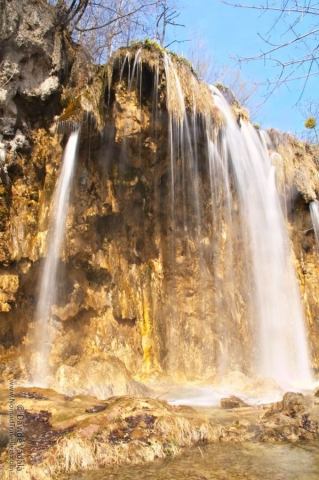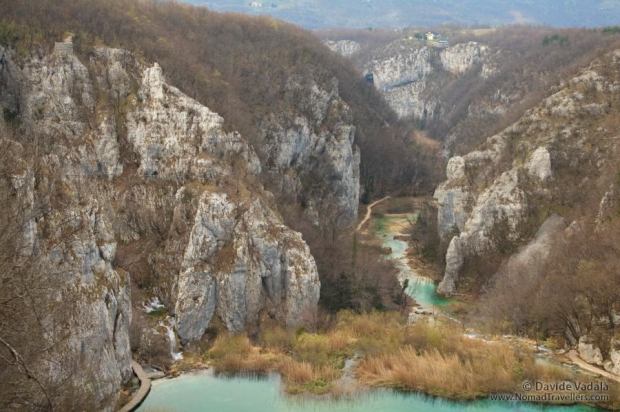 One of the amazing waterfalls in Plitvice Lakes National Park
One of the amazing waterfalls in Plitvice Lakes National Park
Plitvice Lakes National Park Hiking toward the Upper Part is an amazing mother nature's gift, composed of 16 interconnected lakes, and part of the Unesco World Heritage List since 1979.
Hiking toward the Upper Part is an amazing mother nature's gift, composed of 16 interconnected lakes, and part of the Unesco World Heritage List since 1979.
A little bit about Plitvice Lakes National Park
Plitvice Lakes are divided into four main parts: Proscansko Lake, the upper lakes, Kozjak Lake and the lower lakes; at the end it is transforming again into the river Korana, flowing through a steep canyon.
Small waterfalls and flowing water that connect a series of basins at different heights; scenic foot bridges passing over the crystal clear water, giving the chance to be part of this amazing show: this is what is called Plitvice Lakes National Park. And the show is changing continuously, not only with the seasons, but also in time: in fact during the years new waterfalls and lakes are created and old one disappear. Kozjak lake in example, was originally split into two different lakes that merged together: nowadays it's still possible to see underwater A foot bridge over the clear water in Plitvice Lakes the old dam, about 4 meters below the surface. This is due to the formation process behind Plitvice Lakes National Park: the basins are created by natural dams made of travertine, which nature change continuously with the creation of new sediments and the destruction of old one. I already experienced a similar process, in another unforgettable place: Pamukkale in Turkey.
A foot bridge over the clear water in Plitvice Lakes the old dam, about 4 meters below the surface. This is due to the formation process behind Plitvice Lakes National Park: the basins are created by natural dams made of travertine, which nature change continuously with the creation of new sediments and the destruction of old one. I already experienced a similar process, in another unforgettable place: Pamukkale in Turkey.
How we got to Plitvice Lakes National Park
On our trip back hitchhiking from Romania to Italy, we weren't actually planning to stop in Plitvice Lakes National Park. But sometimes things just have to go the way they do, and in this case it was a very welcome surprise. We didn't know anything about Plitvice Lakes National Park until a few weeks before going there; then we started to hear it more and more from people suggesting it on our way, and after some quick researches in internet the decision was never so easy to take. That's how we ended up in Plitvice Lakes National Park, at the end of March of one year ago.
For the first time in the last 3 years of backpacking, we take a room: not a good choice
 Part of Kozjak lakeComing from some days of "wild" camping in Zadar, and some more hundreds km hitchhiking, we took the "exceptional" decision for us, to rest a little bit, pay for a room and enjoy one night of comfort. It actually was the only night in the last 3 years of backpacking that I paid for an accommodation! Plitvice was an high point of our trip and we wanted to sleep well. After asking around to locals and trying all of our options, we eventually took a room in the village of Mukinje, the closest to the main entrance of Plitvice Lakes National Park, connected to it through an easy walk through the woods. We paid 25€ for a double room, more than we were expecting according to what we found in internet and being off season. Stopping in a farther away village could have saved us some bit of cash, and more than that, could have rescued us from an annoying experience with the home owner that turned our unique decision into a nightmare. Not a good experience after you decide to pay once in a few years.
Part of Kozjak lakeComing from some days of "wild" camping in Zadar, and some more hundreds km hitchhiking, we took the "exceptional" decision for us, to rest a little bit, pay for a room and enjoy one night of comfort. It actually was the only night in the last 3 years of backpacking that I paid for an accommodation! Plitvice was an high point of our trip and we wanted to sleep well. After asking around to locals and trying all of our options, we eventually took a room in the village of Mukinje, the closest to the main entrance of Plitvice Lakes National Park, connected to it through an easy walk through the woods. We paid 25€ for a double room, more than we were expecting according to what we found in internet and being off season. Stopping in a farther away village could have saved us some bit of cash, and more than that, could have rescued us from an annoying experience with the home owner that turned our unique decision into a nightmare. Not a good experience after you decide to pay once in a few years.
Let's start hiking around Plitvice Lakes!
 Another beautifull waterfall in Plitvice LakesIn the morning we are again up and excited, despite the grumpy woman, to go and visit Plitvice Lakes: there are two entrance points, but off season only one is open, and actually since we didn't see anybody, and there are no fences in the park, we just squeezed inside. The entrance ticket in high season is about 15€ for one day, a little bit hefty for a budget traveler, but a good deal for normal tourists. And anyway it's definitely worth the money also for a backpacker: travel to Plitvice is an occasion not to be missed.
Another beautifull waterfall in Plitvice LakesIn the morning we are again up and excited, despite the grumpy woman, to go and visit Plitvice Lakes: there are two entrance points, but off season only one is open, and actually since we didn't see anybody, and there are no fences in the park, we just squeezed inside. The entrance ticket in high season is about 15€ for one day, a little bit hefty for a budget traveler, but a good deal for normal tourists. And anyway it's definitely worth the money also for a backpacker: travel to Plitvice is an occasion not to be missed.
The best way to visit the lakes, is to follow a loop, either clockwise or counter clockwise; we did it clockwise. Along the way there are also shuttle bus services and ferries for the lazy people, included in the entrance ticket. Since we passed only one day at Plitvice Lakes, we decided not to hike around Proscansko Lake, that didn't look more than a "normal" lake, and we preferred to invest more time in visiting the peculiarities of this Park.
We weren't there in the best season of the year: end of march means that the environment it's still looking gray, the trees are naked, and there isn't so much water flowing in the lakes. But every season has his advantages: if in Winter you can admire the unusual look given by the snow and the frozen water, in spring the luxurious vegetation is coming back, in summer you can enjoy the unusually refreshing micro-climate, when we were there we had the pleasure to stay away from the crowds of tourists, that usually are stepping one over the other during peak season.
 One of the waterfalls in the Lower partThe Upper part is composed of a multitude of small lakes connected by waterfalls and crossed by foot bridges. Each lake is named and has an explicative panel with the cross section, the height and the capacity of the basin. From the Upper part it's possible to hike to the Lower part of Plitvice Lakes, or to take a ferry that it's crossing Kozjak Lake and leaving you directly on the other side. The Lower part is wider than the upper one and the lakes are bigger: it's possible to walk on the pedestrian bridges over the water or to hike up in the cliffs, where the view is opening toward the canyon
One of the waterfalls in the Lower partThe Upper part is composed of a multitude of small lakes connected by waterfalls and crossed by foot bridges. Each lake is named and has an explicative panel with the cross section, the height and the capacity of the basin. From the Upper part it's possible to hike to the Lower part of Plitvice Lakes, or to take a ferry that it's crossing Kozjak Lake and leaving you directly on the other side. The Lower part is wider than the upper one and the lakes are bigger: it's possible to walk on the pedestrian bridges over the water or to hike up in the cliffs, where the view is opening toward the canyon  The river Korana flowing through the canyonon one side, and the waterfalls on the other. Our suggestion is to walk both the options, and to visit also the "big waterfall" and the caves on the other bank of the river.
The river Korana flowing through the canyonon one side, and the waterfalls on the other. Our suggestion is to walk both the options, and to visit also the "big waterfall" and the caves on the other bank of the river.
We finished our day going back to our accommodation: Plitvice Lakes was over for us and this time we decided to abandon the room and the grumpy woman to go back to our hitchhikers standards: camping inside an empty souvenir stand!














